Bridge Wire: High-Current Ignitor Construction
The "exploding bridge wire" is commonly used as the core of an
ignitor. Electric current is passed through a thin wire, making
it get really hot. Thus it ignites whatever pyrogen is placed
next to it.
The following bridge wires can be
fired
with a 12 volt car battery, such as is commonly used at rocket-club
launches.
At home I use 110volt AC house current through long drop cords, lending
credence
to the term "exploding bridge wire." They burst with enthusiasm.
These are for ground-based
ignition only, where lots of current is
available.
They will NOT fire from a 9-volt battery, so DO NOT attempt to use them
with your
altimeter or staging device!
Materials and equipment:
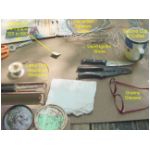
Well, I don't really need all of this stuff but I am a junk freak,
and most of it will be used before this project is finised.
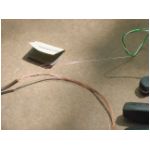
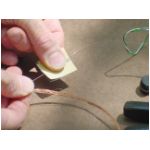
The bridge wire is the interior of a lamp cord. Stripping the
insulation from 6 inches or so to reveals 40 or 50 very thin
strands.
These measure .006 inch on my caliper. Separate one strand from
the
bundle and draw it through the superfine sandpaper until it
gleams.
This will make soldering much easier. Sand gently, especially if
using the "coarser" 320 grit sandpaper, as these strands break very
easily. 600 grit is ideal, if you have it.
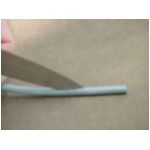
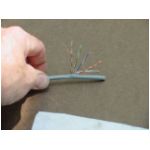
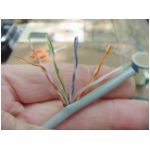
The computer geeks at my workplace are always throwing out sections
of network cable. I lurk around the corner, sneak up to the trash
pile, grab a cable, wrestle it to the ground and subdue it with a
knot.
Whew!
A sharp knife is used to slit the covering two or three inches down,
revealing four pairs of wires, neatly twisted together. Hence the
name "twisted pair" cable. They are nicely color-coded, and are
ideal
for making these ignitors.
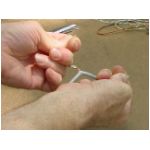
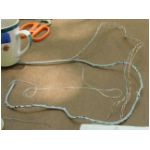
Then I pull and pull to get more of the covering off. This is
a lot of work, partly because there isn't much to grip, and the
covering
tends to break if you go at it too hard.
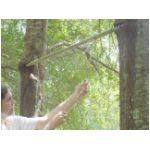
Once a foot or two is stripped, I tie the covering to something sturdy
and use both hands. This makes it easier to apply just the right
pull.
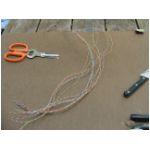
Here I have cut 2-foot sections for 8 potential ignitors. I like
to start with long wires. They can be re-used by cutting off any
damaged sections after use. Long, virgin ignitors are good for
launches.
Short, experienced ones are fine for static tests and ignitor
experiments.
This saves a bit of work.
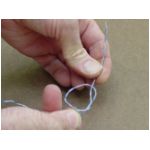
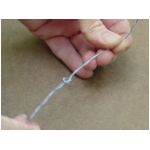
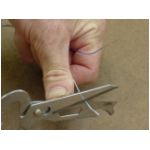
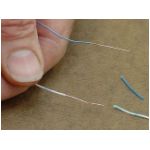
A knot is tied 4 to 6 inches from one end. The wires are
untwisted
up to the knot, knot keeps them from separating any further.
About
1 inch of insulation is stripped from each wire. Sometimes I
wonder
if I should wait on this, for safety purposes to prevent accidental
ignition,
and to keep the wire clean until launch time. Then I get paranoid
about coming up to the launch stand without a wire-stripper, so I go
ahead
an strip them.
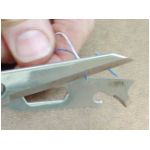
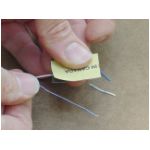
Now to the other end, where the bridge wire will go. The wires
are untwisted about 2 inches, and one of them is cut 1/2 inch shorter
than
the other. About 1/8 inch of insulation is stripped from the end
of each wire. If a stripped end is not shiny, sand it or scrape
it
clean!
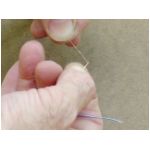
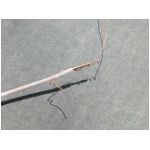
The fine bridge wire is wrapped 3 or 4 times around the stripped end of
the short wire. Apologies for the last picture, the wire had
slipped
partly off. I corrected this error before soldering, but forgot
to
get a photo.
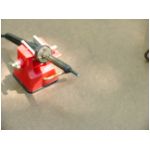
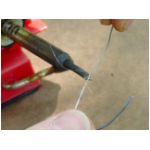
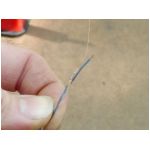
These thin wires are pretty squirrely to handle, so I find it better
to clamp down the soldering iron and bring the wires to it.
Tug gently on the bridge wire after soldering. If it slips
off, it didn't get soldered. Do it again.
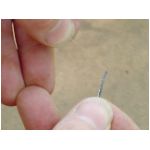
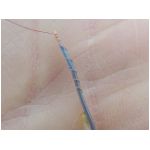
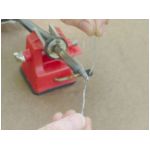
Now twist the wires back together, at least as tightly as they were
before. This is to reduce the strain on the thin bridge
wire.
Wrap the bridge wire strand around the longer wire 4 or 5 times on the
insulation, then 3 or 4 times on the stripped end. Solder the
end.
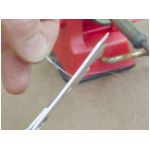
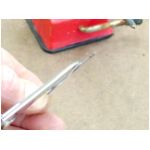
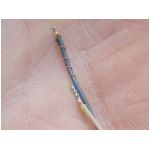
Now I like to trim the loose ends, usually cutting off a bit of the
network
wire at the far end, and getting rid of any frills at the shorter
end.
Isn't it pretty!
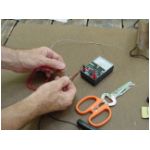
Not a bad idea to test these with the voltmeter for continuity.
But I usually don't. They invariably work at this point.
More
important is to test one just before an important firing, to be sure
the
slings and arrows of time and travel have not broken the bridge or
compromised
a solder-joint.
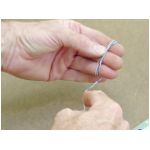
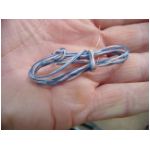
Longer ignitors are wrapped around three fingers. Shortish ones
around two. This makes it easy to find the right length on the
first
pick.
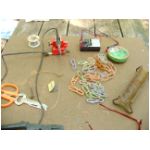
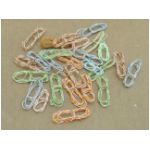
So here is today's production. Took me about an hour to do
this.
Some folks prefer to buy ignitors. That is fine with me. I
prefer to make everything I can.
To be an effective ignitor, these will need some pyrogen. That
web page is coming, but the short of it is: wrap the bridge-wire
end in masking tape with 1/4 gram of black powder. Add a few
magnesium to titanium
turnings for more heat. These work very well with my candy
motors. I am testing fuse
paper for use as the ignitor pyrogen. It is exceedingly cheap
and easy, and in my tests so far has worked quite well.
Question: Why
aren't you using Nichrome? Isn't it better?
Answer: It isn't needed when
plenty of current is available. And copper is virtually free,
pretty, and solders easily.
These ignitors have proven very reliable for me. In several
hundred tests over the last three years, I have had a few ignition
failures. All of them have occurred either because the pyrogen
did not ignite the propellant, or because the power did not get
delivered to the ignitor. Not once has the bridge wire failed to
ignite the pyrogen. It's hard to imagine how nichrome could be
better in that regard.
Nichrome is better is when current is limited, such as in
flight. Using very fine nichrome wire, one should be able to make
ignitors like this which could fire from a small battery. Thus
they could be used with battery-powered altimeters, timers, or staging
devices.
But I have another cheap and easy
trick for that...
Jimmy Yawn
jyawn@sfcc.net
9/15/03
rev. 4/13/05
Recrystallized Rocketry































